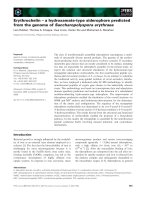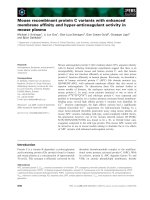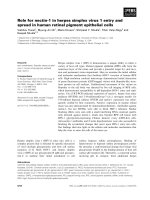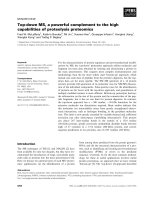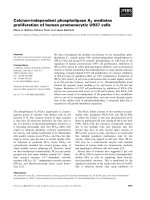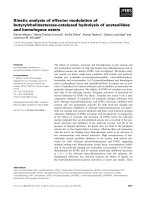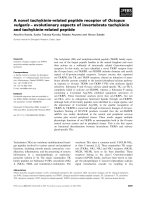Tài liệu Báo cáo khóa học: Quantitative analysis, using MALDI-TOF mass spectrometry, of the N-terminal hydrolysis and cyclization reactions of the activation 2 process of onconase pdf
Bạn đang xem bản rút gọn của tài liệu. Xem và tải ngay bản đầy đủ của tài liệu tại đây (263.31 KB, 9 trang )
Quantitative analysis, using MALDI-TOF mass spectrometry, of the
N-terminal hydrolysis and cyclization reactions of the activation
process of onconase
2
Marc Ribo
´
1
, Montserrat Bosch
1
, Gerard Torrent
1
, Antoni Benito
1
, Bruno Beaumelle
2
and Maria Vilanova
1
1
Laboratori d’Enginyeria de Proteı
¨
nes, Departament de Biologia, Facultat de Cie
`
ncies, Universitat de Girona, Girona, Spain;
2
UMR 5539 CNRS, Department Biologie-Sante
´
, Universite
´
Montpellier II, Montpellier, France
Onconase, a member of the ribonuclease superfamily, is a
potent cytotoxic agent that is undergoing phase II/III human
clinical trials as an antitumor drug. Native onconase from
Rana pipiens and its amphibian homologs have an N-ter-
minal pyroglutamyl residue that is essential for obtaining
fully active enzymes with their full potential as cytotoxins.
When expressed cytosolically in bacteria, Onconase is
isolated with an additional methionyl (Met1) residue and
glutaminyl instead of a pyroglutamyl residue at position 1 of
the N-terminus and is consequently inactivated. The two
reactions necessary for generating the pyroglutamyl residue
have been monitored by MALDI-TOF MS. Results
show that hydrolysis of Met()1), catalyzed by Aeromonas
aminopeptidase, is optimal
3
at a concentration of ‡ 3
M
guanidinium-chloride, and at pH 8.0. The intramolecular
cyclization of glutaminyl that renders the pyroglutamyl
residue is not accelerated by increasing the concentration of
denaturing agent or by strong acid or basic conditions.
However, temperature clearly accelerates the formation of
pyroglutamyl. Taken together, these results have allowed the
characterization and optimization of the onconase activa-
tion process. This procedure may have more general appli-
cability in optimizing the removal of undesirable N-terminal
methionyl residues from recombinant proteins overexpres-
sed in bacteria and providing them with biological and
catalytic properties identical to those of the natural enzyme.
Keywords: onconase; cytotoxicity; recombinant protein
activation; MALDI-TOF mass spectrometry.
4
N- or C-terminal modifications constitute post-translational
modifications that can modulate a peptide activity and/or
resistance to degradation, as is the case with acetylation,
pyroglutamyl formation or C-terminal amidation. Many
proteins and bioactive peptides exhibit an N-terminal
pyroglutamyl, which subsequently minimizes their suscep-
tibility to degradation by aminopeptidases, although it may
also play a crucial role at the functional level [1]. This
residue is also a frequent determinant of overall peptide
function, as has been shown by the hypothalamic releasing
factor binding to its receptor [2], or by the amyloid b-peptide
and the implications in senile plaque formation and
pathogenesis in Alzheimer’s disease [3].
Onconase (ONC) is a ribonuclease that is present in the
oocytes and early embryos of the frog, Rana pipiens [4].
ONC, discovered as a result of its potent anticancer activity
[5], is now in Phase III human clinical trials for the
treatment of several types of cancer [6]. The enzyme, isolated
from frog oocytes, has an N-terminal pyroglutamyl residue
that contributes to the structure of its active site [7] and also
to its stability [8]. This N-terminal pyroglutamyl residue
is produced in vivo by the cyclization of the N-terminal
glutamyl residue. Pyroglutamyl N-termini have been found
in other frog ribonucleases that also display interesting
cytotoxic and antitumoral properties [9]. It has been
reported that non-natural N-terminal residues correlate
with a decrease in the catalytic activity and cytotoxicity of
these enzymes [10]. The interest in ONC as a therapeutic
agent has led to the expression of ONC recombinants,
created using site-specific mutagenesis, in order to study the
molecular determinants of its biological action.
5
The production of unfused proteins from recombinant
vectors generates a cytosolic protein with an additional
methionyl residue at the N-terminus. When ONC is
produced with an N-terminal methionyl residue, Met1, it
retains only 2% of the ribonucleolytic activity of the native
enzyme and is an ineffective cytotoxin, despite being folded
properly [11].
However, cytosolic expression of the ONC in Escheri-
chia coli is interesting because it produces higher yields than
the alternative, secretory approach [12]. Initially, an ONC
Correspondence to M. Vilanova, Laboratori d’Enginyeria de
Proteı
¨
nes, Departament de Biologia, Facultat de Cie
`
ncies,
Universitat de Girona, Campus de Montilivi, 17071 Girona, Spain.
Fax: + 34 972 418150, Tel.: + 34 972 418173,
E-mail:
Abbreviations: AAP, aminopeptidase of Aeromonas proteolytica;
CNBr, cyanogen bromide; DMEM, Dulbecco’s modified Eagle’s
medium; (Gln1)-ONC (M23L), onconase variant with a Gln1 and
leucine replacing methionine at position 23; GSH, reduced gluta-
thione; GSSG, oxidized glutathione; IC
50
, 50% inhibitory
concentration; IPTG, isopropyl thio-b-
D
-galactoside; (Met1)-ONC
(M23L), onconase variant with a methionine preceding Gln1;
ONC, Onconase; (Pyr)-ONC (M23L), onconase variant with a
pyroglutamyl residue at position 1 and leucine replacing methionine
at position 23; rONC, wild-type recombinant onconase.
(Received 10 December 2003, revised 28 January 2004,
accepted 3 February 2004)
Eur. J. Biochem. 271, 1163–1171 (2004) Ó FEBS 2004 doi:10.1111/j.1432-1033.2004.04020.x
variant, with the change M23L, was designed as a strategy
for obtaining recombinant ONC upon removal of (Met1) by
treatment with cyanogen bromide (CNBr) [13]. Notomista
and co-workers [12] showed that M23L substitution
increased the catalytic activity of this variant relative to the
native enzyme, but did not modify its potential as a
cytotoxin. Alternatively, the exopeptidase Aeromonas amino-
proteolytica aminopeptidase (AAP) [14] has proved to be
useful in removing Met1 from other ribonucleases, such as
angiogenin [15] and bovine seminal ribonuclease [16]. When
using (Met1)-ONC (M23L) as a substrate, it was found
necessary to completely denature and reduce the protein
in order to efficiently remove the methionyl residue [12].
Although, unlike CNBr treatment, the procedure did not
generate secondary products, it was very time consuming.
6
In this work we have characterized, using MALDI-TOF
MS, the two reactions involved in the activation process of
(Met1)-ONC (M23L) and established a rapid procedure to
activate the enzyme, without the need for reducing it once
purified. By using the purified recombinant protein, the
conversion of reagents and products of the exopeptidase-
catalyzed hydrolysis of Met1 and cyclization of Gln1 to
pyroglutamyl were monitored at different time-points
during the reaction by the acquisition of mass spectra. This
enabled us to calculate the fraction of each species present at
a particular instant and under particular conditions. This
strategy was used to characterize the factors that affect the
reactions, as well as those responsible for optimizing the
process to produce high yields of fully active ONC. This
experimental design may also be extended to other protein
systems where the undesired presence of additional residues
has a negative effect on their activity, modifies their
antigenicity or affects their conformational stability
7
.
Materials and methods
Materials
Recombinant (Met1)-ONC (M23L) was expressed in E. coli
BL21(DE3) cells harboring pET11d-(Met1)-ONC (M23L),
and rONC was produced from E. coli BL21(DE3) cells
transformed with pONC. Both vectors were kindly provi-
ded by Dr R. T. Raines (University of Madison, Madison,
WI, USA), and were as described previously [13]. RNase A
was produced as described previously [17]. The E. coli
strain, BL21(DE3), was obtained from Novagen (Madison,
WI, USA), the Mono-S HR 5/5 column from Amersham
Biosciences (Piscataway, NJ, USA), and [
35
S]methionine
from ICN-Biomedicals (Irvine, CA, USA). Cell lines were
provided by American Type Culture Collection (Manassas,
VA, USA). Dulbecco’s modified Eagle’s medium (DMEM)
and fetal bovine serum were provided by Invitrogen
(Carlsbad, CA, USA).
Protein expression
BL21(DE3) cells, transformed either with plasmid pET11d-
(Met1)-ONC (M23L) encoding (Met1)-Gln1-ONC with
a Met in position 23 substituted by Leu, or with plasmid
pONC encoding Gln1-ONC, were grown to an attenuance
at 550 nm (D
550
)of 1.0–1.5 in LB (Luria–Bertani)
medium containing 100 lgÆmL
)1
ampicillin. Protein
expression was induced by the addition of isopropyl thio-b-
D
-galactoside (IPTG) to a final concentration of 1.0 m
M
.
After 3 h, the cells were collected by centrifugation, and the
cell pellets were stored at )20 °C.
Protein purification
Both (Met1)-ONC (M23L) and rONC were purified
according to a previously described procedure [18]. Briefly,
frozen pellets from 1 L of induced culture were resuspended
in 30 mL of 50 m
M
Tris/HCl, 10 m
M
EDTA, pH 8.0; the
cells were lysed by French Press and inclusion bodies were
harvested by centrifugation (12 000 g,45min,4°C). The
pellets were then resuspended in 10 mL of 6
M
guanidinium
chloride, 2 m
M
EDTA, 100 m
M
Tris-acetate, pH 8.5, to
permit the solubilization of proteins from inclusion bodies.
The samples were reduced by the addition of glutathione
(GSH) to a final concentration of 0.1
M
,thepHwas
adjusted to 8.5 with solid Tris, and the samples were
incubated at room temperature for 2 h under a nitrogen
atmosphere. Insoluble material was then removed by
centrifugation (12 000 g,30min,4°C). Solubilized protein
was diluted dropwise ( 100-fold), to a final concentration
of 50–100 lgÆmL
)1
,into0.5
ML
-arginine, 1 m
M
oxidized
glutathione (GSSG), 2 m
M
EDTA, 0.1
M
Tris-acetate,
pH 8.5, and then incubated at 10 °Cforatleast24h.To
prevent refolding, the pH was adjusted to 5.0 with acetic
acid. The sample was then concentrated by ultrafiltration
and dialyzed against 50 m
M
sodium acetate, pH 5.0. Preci-
pitated or insoluble material was eliminated by centrifu-
gation (12 000 g,10min,4°C). The refolded sample
was then loaded onto a Mono-S HR 5/5 FPLC column,
and recombinant onconases were eluted with a linear
gradient of 0–600 m
M
NaCl in 30 min. Fractions containing
the pure (Met1)-ONC (M23L) or rONC were dialyzed
against ultrapure water, lyophilized and stored at )20 °C.
Hydrolysis and cyclization as a function of guanidinium
chloride concentration and pH
(Met1)-ONC (M23L) (0.1 m
M
) was prepared in 0.2
M
potassium phosphate buffer containing 0.5 m
M
ZnSO
4
with varying guanidinium chloride concentrations (0, 2, 3,
4.5 and 6
M
) and at different pH values (6.2, 7.2 or 8.0).
The samples were equilibrated for 30 min at 37 °C.
The hydrolysis reaction was started by adding 1 lLof
4 · 10
)6
M
AAP in the appropriate buffer to obtain a
1 : 2500 molar ratio (AAP : ONC)
8
, and incubated at
37 °C. Aliquots of 2 lL were taken at 0, 1, 2, 4, 6, 8, 24
and 30 h, diluted 10-fold in 0.1% TFA-CH
3
CN (2 : 1),
mixed with an equal volume of saturated sinapinic acid in
the same solvent of the matrix, and 0.5 lL of the mixture
was immediately applied to a sample probe spot.
Cyclization reaction as a function of pH and temperature
In order to determine the effect of pH and temperature on
the cyclization of the N-terminal glutaminyl to pyrogluta-
myl, 0.1 m
M
(Met1)-ONC (M23L), in 0.2
M
potassium
phosphate buffer containing 0.5 m
M
ZnSO
4
,3
M
guanidi-
nium chloride, pH 8.0, was equilibrated for 30 min at
37 °C. The hydrolysis reaction was started, as described
1164 M. Ribo
´
et al. (Eur. J. Biochem. 271) Ó FEBS 2004
above, and allowed to proceed for 1 h. Once completed, the
sample was split into different aliquots, the pH was adjusted
to 2.5, 8.0 and 11.5, and aliquots of each pH value were
incubated at 37 °C, 50 °Cand70°C, respectively. From
these, aliquots of 2 lL were taken at 0, 1, 2, 4, 6 and 24 h,
and prepared for MS analysis as described above
9
.
MALDI-TOF MS
All mass spectra were acquired on a Bruker ULTRAFLEX
TOF mass spectrometer, at the Servei de Proteo
`
mica i
Bioinforma
`
tica (Universitat Auto
`
noma de Barcelona,
Barcelona, Spain), equipped with a nitrogen laser with an
emission wavelength of 337 nm. Spectra were obtained in
the linear positive mode at an accelerating voltage of 25 kV,
and deflection of the low mass ions m/z<5000 U was used
to enhance the target protein signal. Fifty spectra were
accumulated from 10-shot runs using the automatic mode
in order to minimize subjectivity. The criteria for acceptance
were a resolution greater than 1000 (m/FWHM) and a
signal-to-noise ratio greater than 10. Each data point was
averaged from two independent experiments. For each
experiment, mass spectra were acquired from duplicates.
The accuracy in mass determination obtained for the
different species was ± 2 U. Mass values given through-
out the text correspond to protonated molecular ions
[M+H]
+
.
Activation of onconase
A 10 mg sample of (Met1)-ONC (M23L) was dissolved at
a concentration of 1 m
M
in 0.2
M
potassium phosphate,
0.5 m
M
ZnSO
4
,3.0
M
guanidinium chloride, pH 8.0. AAP
was added to the solution at a molar ratio of 1 : 2500
(AAP : ONC) and the mixture was incubated for 1 h at
37 °C followed by a 3 h incubation at 70 °C. The protein
was dialyzed overnight at 10 °Cagainst20m
M
potassium
phosphate, pH 7.2. Finally, the protein was purified by ion-
exchange chromatography in a Mono S HR 5/5 FPLC
column, using a linear gradient of 0–200 m
M
NaCl in
20 m
M
potassium phosphate, pH 7.2, for 25 min. Pyr-ONC
(M23L), eluted as a single peak, was dialyzed against ultra
pure water to remove salts, then lyophilized.
Determination of conformational stability
The conformational stability of (Met1)-ONC (M23L) and
Pyr-ONC (M23L) was determined using UV spectroscopy
to measure the change in environment of the aromatic
residues during protein thermal unfolding. The proteins
were dissolved at 0.5 mgÆmL
)1
in a buffer of 50 m
M
glycine/
HCl, pH 2.0, and the UV absorbance was monitored
at 278 nm. The temperature was raised from 35 to 80 °C
in 2 °C increments. The decrease in UV absorbance was
registered after a 5 min equilibration at each temperature.
Reversibility was verified by decreasing the temperature in
10 °C decrements, equilibrating the sample for 10 min and
monitoring the absorbance at 278 nm. Unfolding transi-
tions curves induced by temperature were fitted to a two-
state thermodynamic model combined with sloping linear
functions for the native and denatured states, as described
previously [19]. The free energy of thermal unfolding (DG
U
)
was calculated as described previously [17]. The DCp value
for (Met1)-ONC (M23L) and rONC was taken from
a previous publication [20]. Curves were normalized to
facilitate comparison of the unfolding transitions induced
by temperature.
Cytotoxicity assays
Cytotoxicity was evaluated by measuring the incorporation
of [
35
S]methionine into newly synthesized cell proteins.
Human chronic myelogenous leukemia cells, K562, and
human epidermoid carcinoma cells, A431, were grown at
37 °C in DMEM, supplemented with 2 m
ML
-glutamine,
50 UÆmL
)1
penicillin, 50 UÆmL
)1
streptomycin and 10%
fetal bovine serum, in a humidified incubator containing 5%
CO
2
(v/v). Both cell types were cultured in 96-well plates, at
adensityof2.5· 10
4
cellsÆmL
)1
. A431 cells were allowed to
attach for 2 h before the addition of ONC. After 3 days,
[
35
S]methionine was added (500 000 c.p.m. per well).
Twenty-four hours later, the cells were lysed with NaOH
and the protein precipitated with 15% trichloroacetic acid
(w/v). These proteins were collected onto glass fiber filters
using a cell harvester, washed with 5% trichloroacetic acid
(w/v), and radioactivity was counted using a liquid scintil-
lation counter. Background levels were obtained from cells
treatedwith1m
M
cycloheximide [21]. The results are
expressed as a percentage of control values obtained from
samples without ONC. The data for a single experiment
was the average of four determinations and experiments
were repeated three times. The IC
50
values represent the
ONC concentration that inhibited the cell protein
synthesis by 50%.
Other methods
ONC concentration was determined by UV spectroscopy,
using an extinction coefficient of 10 280
M
)1
Æcm
)1
[22]. AAP
concentrations were also determined spectrophotometri-
cally using an extinction coefficient of E
1%
1cm
¼ 14.4, at
278.5 nm [23]. Protein sequence determinations were per-
formed on a LF-3000 Beckman-Coulter sequencer, connec-
ted online to an HPLC apparatus for the identification of
the phenylthiohydantoins, at the Servei de Proteo
`
mica
i Bioinforma
`
tica (Universitat Auto
`
noma de Barcelona).
Electrophoresis on polyacrylamide gels under denaturing
conditions (SDS/PAGE) was carried out as described
previously [24].
Results
Expression and purification of recombinant onconases
Recombinant (Met1)-ONC (M23L) was expressed in the
cytosol of E. coli, whilst rONC was targeted to the
periplasmic space using a signal sequence. Both proteins
were purified according to the procedure described previ-
ously [18]. After purification, both recombinant products
were chromatographically homogeneous and migrated as
single species of identical relative mass when assayed by
SDS/PAGE (data not shown). For recombinant (Met1)-
ONC (M23L), the yield was typically 15–20 mgÆL
)1
of
culture, which was, on average, double the yield observed
Ó FEBS 2004 MS characterization of onconase activation
1
(Eur. J. Biochem. 271) 1165
for rONC. This correlates well with the observation of
an induction band only in the SDS/PAGE analysis of
crude extracts of BL21(DE3)-pET11d-(Met1)-ONC (M23L)
induced cells. These yields were comparable to those
obtained by using other methods for the production and
purification of the enzyme [13]. The molecular mass of each
purified product, as measured by MALDI-TOF MS, was
11 947.87±2 for (Met1)-ONC (M23L) and 11 838.21±2
for rONC, which conforms well to the expected values:
11 949.90 for (Met1)-ONC (M23L) and 11 836.82 for
rONC with a glutaminyl residue at the N-terminus.
Reaction monitoring by MALDI-TOF MS
To determine the optimal technical conditions for acquiring
the spectra, we ran experiments in which samples were taken
at a specific time and placed on a probe spot. As soon as the
samples were dry, the probe was transferred into the mass
spectrometer so that spectra could be acquired immediately.
The mass spectra for the same samples were acquired again,
24 h and 72 h later. Comparing the peaks of the different
spectra revealed that they were indistinguishable in relative
intensity. Probably dehydration, together with acidification
and dilution of the samples, stopped the reactions. This
finding allowed the acquisition of spectra in the automatic
mode, once all the samples had been taken and placed on
the sample probe spot. A second relevant technical aspect
was that the three species under study (Met1)-ONC
(M23L), Gln1-ONC (M23L) and Pyr-ONC (M23L) were
resolved in the same spectrum. In Fig. 1, a time-course
graph showing the conversion from the reactive to the final
product is presented. It is clear, from the figure, how the
three species are clearly identifiable and how their intensities
vary with time, allowing the fraction of each species to be
determined at any time.
Characterization of the hydrolysis reaction
Met1 removal. The election of the buffer system was based
on previous studies on AAP activity [23] and on the
influence of ions in the cyclization reaction [25]. Both studies
coincided in that phosphate was the system of choice – while
it was recommended for the exopeptidase activity, it also
accelerated the conversion of glutaminyl to pyroglutamyl
residues.
The hydrolysis reaction was monitored by calculating the
sum of the relative intensities of the peaks corresponding to
Gln-ONC (M23L) (theoretical molecular mass 11 818.87)
and Pyr-ONC (M23L) (theoretical molecular mass
11 801.60), and expressing it as the fraction of hydrolyzed
(Met1)-ONC (M23L).
Figure 2 shows the results of the characterization of the
hydrolysis reaction as a function of guanidinium chloride
concentration and pH. In order to make the differences
between the analyzed conditions clearer, only the values
for the first 8 h are shown. Within this period of time, and
under specific conditions, the hydrolysis reaction is com-
plete. When analyzing at the effect of guanidinium chloride,
it is notable that hydrolysis is favored by the increase in
guanidinium chloride concentration, being completed in as
little as 1–2 h at pH 7.2 or pH 8.0, when the guanidinium
chloride concentration is ‡ 3
M
. At pH 6.2, significant
differences can be observed in terms of guanidinium
chloride concentrations and the extent of the hydrolysis
reaction, which does not reach completion, in any case,
before the first 8 h. At 3
M
guanidinium chloride, the
reaction is complete within 24 h; however, it is still only
partially complete after 30 h at 0
M
(60%) and 2
M
(80%)
guanidinium chloride.
At pH 7.2, the differences in terms of guanidinium
chloride concentrations and Met1 removal are also clear.
In this case, the reaction is favored by higher guanidinium
chloride concentrations, being completed in 1 h at 4.5
M
and 6
M
guanidinium chloride (data not shown), in 2 h at
3
M
guanidinium chloride, whereas it does not reach
completion (90%) after 30 h of digestion at lower guani-
dinium chloride concentrations. Finally, hydrolysis at
pH 8.0 was completed at all the guanidinium chloride
concentrations assayed: it takes 1, 8 and 24 h at 3, 2 and 0
M
guanidinium chloride, respectively. In short, the hydrolysis
reaction was clearly slowed down by decreasing the
concentration of denaturing agent or lowering the pH. At
‡ 3
M
guanidinium chloride, and at pH 7.2 or pH 8.0, the
reaction was complete within 1–2 h.
Characterization of the intramolecular cyclization
reaction
Pyroglutamyl formation. From the set of data described in
the preceding section, it was also possible to monitor the
cyclization reaction as a function of guanidinium chloride
concentration and pH, by calculating the fraction of Pyr-
ONC (M23L) or cyclization. This is defined as the ratio
Fig. 1. Mass spectra [(m/z) range 9000–13 000 U] showing the con-
version of (Met1)-ONC (M23L) (an onconase variant with a methionine
preceding Gln1) to (Gln1)-ONC (M23L) (an onconase variant with a
Gln1 and leucine replacing methionine at position 23) and afterwards to
(Pyr)-ONC (M23L) (an onconase variant with a pyroglutamyl residue at
position 1 and leucine replacing methionine at position 23). Samples were
takenat0,1,2,6and24handcorrespondtoanexperimentcarried
outat37°C and pH 8.0 in the presence of 3
M
guanidinium chloride.
1166 M. Ribo
´
et al. (Eur. J. Biochem. 271) Ó FEBS 2004
between the relative intensities [Pyr-ONC (M23L)/Gln-
ONC (M23L) + Pyr-ONC (M23L)]. This value is prefer-
able to measuring only the appearance of Pyr-ONC
(M23L), as this would not be a true estimate of the
cyclization because this second reaction depends on the
hydrolysis reaction. When analyzing this set of data, we did
not find such a strong dependence of cyclization on pH
or guanidinium chloride, as was the case for hydrolysis.
However, when considering only the first 6 h of the
reaction, it was found that the rate of cyclization is almost
linear and can be obtained by calculating the slope of the
curves of Pyr-ONC (M23L) vs. time. From the rates of
cyclizationshowninTable1,itcanbeinferredthatthe
formation of the N-terminal pyroglutamyl is not dependent
on pH in the range 6.2–8.0. Interestingly, however, the
reaction is slowed down when the guanidinium chloride
concentration increases. These results concur with the
observation that the rate of conversion of L-Gln to Pyr in
aqueous solution is minimum at near neutral pH values [26].
To further characterize and establish the optimum
productive procedure for obtaining Pyr-ONC (M23L),
once the optimal hydrolysis conditions had been estab-
lished, we focused our attention on the cyclization reaction.
To evaluate the contribution of both pH and temperature
to the cyclization of the N-terminal glutaminyl to pyroglu-
tamyl, Met1 was completely hydrolyzed from (Met1)-ONC
(M23L) by the addition of AAP, as described in the
Materials and methods. Completion of the hydrolysis was
confirmed by the disappearance of the (Met1)-ONC
(M23L) signal in the MALDI-TOF mass spectra 1 h after
the addition of AAP. The pH was adjusted to 2.5, 8.0 and
11.5 and the samples were incubated at 37 °C, 50 °Cand
70 °C. Aliquots were taken at different time-points from
each sample and analyzed by MALDI-TOF MS. The
addition of the protease is considered the zero time point.
The relative intensities of the peaks from the mass spectra
were used to calculate the fraction of Pyr-ONC (M23L), as
described above. The results are shown in Fig. 3. Because
the cyclization reaction is readily accomplished at very short
times under specific conditions, and to make comparison
easier, only data corresponding to the first 6 h are shown.
Comparing the data obtained for particular temperatures
(Fig. 3), it can be seen that at 37 °C, the reaction was as fast
at pH 2.5 as it was at pH 8.0 for the first 6 h, although
it was not completed before 24 h. At pH 11.5, degradation
by nonspecific hydrolysis was observed after 6 h. At 50 °C,
the protein was degraded after 2 h under basic conditions
and after 6 h under acidic conditions. At this temperature,
the reaction was slightly faster at pH 8.0 than at pH 2.5,
and 95% of Pyr-ONC (M23L) was observed after 6 h.
Finally, data obtained at 70 °C showed that the formation
ofpyroglutamylwascompletedin4hatpH8.0,withno
degradation of the protein. At pH 2.5, although cyclization
was faster at 70 °C when compared with lower tempera-
tures, it was not completed because degradation of the
protein was also observed after 6 h of reaction.
Analysis of the data as a function of pH (Fig. 3), showed
that cyclization at pH 2.5 is faster when the temperature
is increased, although for all the temperatures used in the
assay, the reactions were not complete within the first 6 h.
Fig. 2. Comparison of the hydrolysis reaction as a function of denaturing
agent and pH. (A), (B) and (C): (d), (s)and(.) correspond to
guanidinium chloride concentrations of 0 , 2 and 3
M
, respectively.
Hydrolysis was calculated as described in the Results.
Table 1. Rate of (Pyr1)-ONC (M23L) (an onconase variant with a
pyroglutamyl residue at position 1 and leucine replacing methionine at
position 23) formation as a function of guanidinium chloride concentra-
tion and pH. The rate of (Pyr1)-ONC (M23L) formation was
calculated as the slope of the curves generated by representing the
cyclized fraction, defined as [(Pyr1)-ONC (M23L)/(Gln1)-ONC
(M23L) + (Pyr1)-ONC (M23L)] during the first 6 h of the reaction.
pH
Guanidinium chloride concentration
0
M
2
M
3
M
6.2 0.1155 0.0728 0.067
7.2 0.1269 0.0734 0.066
8.0 0.1133 0.0834 0.067
Ó FEBS 2004 MS characterization of onconase activation
1
(Eur. J. Biochem. 271) 1167
At pH 8.0, cyclization also increased as a function of the
temperature and, at 70 °C, only 4 h of incubation was
required to reach 100% completion. When the temperature
was lowered to 50 °C, 6 h of incubation was required to
obtain 90% Pyr-ONC (M23L), while, at 37 °C, the reaction
was not complete until 24 h after initiation. At pH 11.5, it
was only possible to quantify the sample incubated at 37 °C
up to 6 h because, after this time, extensive degradation of
the sample was observed. At 50 °Cand70°C, the same
phenomenon was observed after just 2 h.
To sum up, under the conditions of the assay, the
intramolecular cyclization of glutaminyl to pyroglutamyl
at the N-terminus of ONC (M23L) is not accelerated by
lowering the pH, as observed for free L-Gln in aqueous
solutions [26]. Strong basic conditions are not recommen-
ded, because protein degradation is observed even after
short reaction times and at 37 °C. The cyclization reaction
is clearly accelerated by temperature and can be completed
in as little as 3 h at 70 °C (4 h after the addition of the
exopeptidase).
Preparative activation
Activation of (Pyr)-ONC (M23L) was performed as
described in the Materials and methods. The presence of
pyroglutamyl at the N-terminus of the protein was
confirmed by protein sequence determination, which resul-
ted in no phenylthiohydantoin derivatives, indicating a
blocked N-terminus.
Protein identity and integrity was also confirmed by
MALDI-TOF MS. The measured molecular mass of the
purified product was 11 799.70 ± 2, which concurs closely
with activated (Pyr)-ONC (M23L), which has a theoretical
molecular mass of 11 801.60.
Contribution of Met1 hydrolysis and pyroglutamyl
formation to the conformational stability of active
onconase
In order to evaluate the contribution of the (Met1)
hydrolysis and pyroglutamyl formation to the global
conformational stability of the protein, the thermal dena-
turation curves of (Met1)-ONC (M23L), Pyr-ONC (M23L)
and rONC were determined at pH 2 in 100 m
M
glycine/HCl
buffer by monitoring the UV absorbance at 278 nm. The
temperature unfolding transitions were reversible and fitted,
as previously described [19], to a two-state thermodynamic
model. In Fig. 4, the normalized curves are shown. The
fitted thermodynamic parameters for thermal transitions are
listed in Table 2. A comparison of the experimental data
collected for the three proteins makes it possible to estimate
the contribution of Met1, and Met23 substituted for Leu,
Fig. 3. Comparison of the cyclization reaction as a function of tem-
perature and pH. (A), (B) and (C): (d), (s)and(.) correspond to
pH 2.5, 8.0 and 11.5, respectively. Cyclization was calculated as des-
cribed in the Results.
Fig. 4. Normalized temperature unfolding curves. Samples at pH 2 in
100 m
M
glycine/HCl buffer were subjected to temperature increase
(2 °C increments) and changes in absorbance at 278 nm, monitored at
each temperature. (m), (s)and(j) correspond to (Met1)-ONC
(M23L) (an onconase variant with a methionine preceding Gln1),
(Pyr)-ONC (M23L) (an onconase variant with a pyroglutamyl residue
at position 1 and leucine replacing methionine at position 23) and
rONC (wild-type recombinant onconase), respectively.
1168 M. Ribo
´
et al. (Eur. J. Biochem. 271) Ó FEBS 2004
to the global stability of ONC. It can be seen that the
N-terminal Met diminished the T
m
10;11
by 6 °CandtheDG
U
10;11
by 3.5 kJÆmol
)1
, whereas substitution of methionine with
leucine at position 23 diminished the midpoint of the
thermal denaturation curve (T
m
)by7°Candthefree
energy of unfolding (DG
U
)by11kJÆmol
)1
. These values are
in very close agreement with those obtained using differen-
tial scanning calorimetry [20], suggesting that the procedure
described in this work for the activation of ONC has no
detrimental effect on the conformational stability of the
enzyme.
Cytotoxic activity
The effect of (Met1) removal on the cytotoxic properties of
ONC was examined on K562 human erythroleukemic cells
and A431 human epidermoid carcinoma cells by measuring
the incorporation of [
35
S]methionine into newly synthesized
proteins after 96 h of incubation with an increasing
concentration of either (Met1)-ONC (M23L) or the activa-
ted Pyr-ONC (M23L). The results are shown in Fig. 5. For
both cell lines, activated Pyr-ONC (M23L) inhibited cell
proliferation, with an 50% inhibitory concentration (IC
50
)
value of 0.3–1 l
M
, several orders of magnitude lower than
those measured for (Met1)-ONC (M23L). IC
50
values in the
l
M
range for ONC have previously been described [27].
These data confirmed that the procedure, described in this
work, used to generate activated Pyr-ONC (M23L), resulted
in a protein that retains its full cytotoxic potential.
Discussion
A great deal of work has been directed towards the
optimization of experimental conditions in order to control
external factors, such as sample preparation methods,
matrix solution conditions and matrix crystal morphology,
which have been shown to affect the peak intensity of
peptides [28]. Recent results suggest that several intrinsic
properties of peptides influence their MALDI behavior.
Besides charged side-chains, the presence of aromatic amino
acids, peptide hydrophobicity, size and the potential to form
stable secondary structures, have been reported as influen-
cing ion intensity. Furthermore, in proteomics, when using
complex systems, so-called suppressive effects were observed
in peptide mixtures, such as those obtained by tryptic
digestion [29].
As, in the present work, we are dealing with a simple
system constituted by only three molecular species, each
very similar in net charge, surface charge distribution,
hydrophobicity and molecular mass, it is worthwhile to
assume that their behavior, in terms of reactivity to the
matrix and their ionization properties, will not differ
significantly. Thus, the relative intensities of the different
peaks constitute a fair estimate of the fraction of each
species in a particular condition or reaction time. This has
allowed us to monitor how they interconvert over time
under the different experimental conditions and to quantify
the process.
Hydrolysis reaction
The enzymatic hydrolysis of (Met1)-ONC (M23L) to
produce (Gln1)-ONC (M23L) was monitored by MALDI-
TOF MS under different guanidinium chloride concentra-
tions and/or pH. It was found that the optimum pH is
pH 8.0. This result is in accordance with the fact that the
maximum stability and activity of the AAP occurs in the
pH range 8.0–8.5 [23]. When evaluating the influence of
Table 2. Thermodynamic parameters of the thermal denaturaturation of the different onconase (ONC) variants at 25 °C and pH 2.0. (C
Gdm/HCl
)
½
13
,
midpoint of guanidinium chloride denaturation curve; DG
U
14;15;16
, free energy of unfolding; DH
Tm
14;15;16
, enthalpy of unfolding calculated at T
m
; T
m
14;15;16
,midpoint
of the thermal denaturation curve. (Met1)-ONC (M23L), an onconase variant with a methionine preceding Gln1; (Pyr1)-ONC (M23L), an
onconase variant with a pyroglutamyl residue at position 1 and leucine replacing methionine at position 23; rONC, wild-type recombinant
onconase. Gdm, guanidinium.
T
m
a
(°C)
DH
Tm
a
(kJÆmol
)1
)
DG
U
(25 °C)
(kJÆmol
)1
)
(C
Gdm/HCl
)
½
b
(
M
)
rONC (wild-type) 65.1 (0.4) 417 (47) 33.8 4.5
(Pyr1)-ONC (M23L) 58.5 (0.2) 355 (29) 26.7 3.4
(Met1)-ONC (M23L) 52.9 (0.08) 345 (32) 23.2 ND
a
Values in parentheses are the standard errors of the data.
b
Values reported previously [20].
Fig. 5. Cytotoxicity of onconase variants to
K-562 and A-431 cell lines. Cell viability was
determined by measuring the incorporation of
[
35
S]methionine into newly synthesized protein
after 96 h of incubation with each onconase:
(d) (Met1)-ONC (M23L) (an onconase vari-
ant with a methionine preceding Gln1) and
(s) (Pyr)-ONC (M23L) (an onconase variant
with a pyroglutamyl residue at position 1 and
leucine replacing methionine at position 23).
The results represent the average of three
experiments.
Ó FEBS 2004 MS characterization of onconase activation
1
(Eur. J. Biochem. 271) 1169
guanidinium chloride on the reaction, the reaction rate
increases with increasing concentrations of guanidinium
chloride.
Enzymatic removal of the N-terminal methionyl residue
from other recombinant ribonucleases, such as angiogenin
[15] and BS-RNase [16], was performed using the AAP [14]
without the need for denaturing agents. However, when the
same approach was attempted with onconase, it was found
that it was previously necessary to reduce and denature the
protein to permit removal of the (Met1) [12], which resulted
in a time-consuming procedure.
AAP is a very stable enzyme, as it tolerates exposure to a
temperature of 70 °C for several hours and is only partially
inactivated in 8
M
urea. The active site, located at the
surface of the protein, is fairly open to the bulk solvent and
is accessible via a solvent channel [30]. Thus, the accessibility
of the peptidase active site does not seem to be a limiting
factor for catalysis under the conditions of this study.
On the other hand, mass peaks corresponding to the
removal of additional residues were not detected, indicating
that the aminopeptidase action was limited to Met1
removal. It has been described that the presence of an
acidic residue in the penultimate position reduces the rate of
release of the N-terminal residue [23]. In onconase, there is
an aspartyl residue in position 2 that could reduce the rate of
hydrolysis to an extent sufficient to allow Gln1 to cyclize to
pyroglutamyl, avoiding its removal. Afterwards, cyclization
prevents further hydrolysis by the aminopeptidase, and a
unique final product is formed.
ONC has an unusually high resistance against guanidi-
nium chloride denaturation and proteases [20]. The closer
positioning of the N-terminus to the main protein body is
essential for these properties as well as for its activity.
Together with a disulfide bridge between the C-terminal
Cys104 and Cys87, it contributes to the overall ONC
stability [8,31]. The midpoint of the guanidinium chloride
denaturation curve of Pyr-ONC (M23L) is 3.4
M
[20]
(Table 2). At low or zero concentrations of guanidinium
chloride, the methionyl residue might be not sufficiently
accessible to the AAP and therefore the reaction is slow. At
3
M
guanidinium chloride, ONC begins to unfold, making
the N-terminal a-helix of ONC more accessible to the active
site of AAP and, thus, the hydrolysis reaction is favored.
High concentrations of guanidinium chloride do not have
a negative effect on the rate of the reaction because, as
mentioned previously, AAP remains active, even at high
concentrations of the denaturing agent.
Cyclization reaction
In contrast to other ribonuclease family members, the
N-terminal residue of ONC (Pyr1) forms part of the active
site [32]. The N-terminal glutamyl residue (Glu1) of ONC
cyclizes to form a pyroglutamyl (Pyr) residue, which folds
back against the N-terminal a-helix (a1) and forms a
hydrogen bond with the CO group of Val96 in the
C-terminal b-sheet. Pyr1 is also hydrogen bonded to the
e-amino group of the Lys9 side-chain, which simultaneously
interacts with the main phosphate of the substrate [32].
The closer positioning of the N-terminus to the main
protein body is essential for the activity and, together with
the 87–104 disulfide bridge, contributes to the high stability
of ONC against temperature [8,31]. Taking advantage of
this property, the cyclization reaction from Gln to Pyr was
evaluated as a function of temperature, up to 70 °C, by
using MALDI-TOF MS. Similarly to many reactions, it
was observed that temperature accelerates the reaction rate.
However, because the substrate is a polypeptide, care was
required with the pH of the reaction. Combining high or
low pH with high temperature resulted in the degradation,
by partial nonspecific hydrolysis, of the polypeptide chain.
When investigating the effect of pH on the cyclization
reaction, we expected that an acidic pH might enhance
the rate of conversion of (Gln1)-ONC(M23L) to (Pyr1)-
ONC(M23L), based on previous studies on the conversion
of free
L
-Gln to Pyr in aqueous solutions which demon-
strated that the reaction was accelerated at acidic pH values
[26]. It is worth mentioning that cyclization of ONC occurs
in the presence of 3
M
guanidinium chloride, because this
was determined as the minimum concentration of guanid-
inium chloride that allowed the maximum rate of hydro-
lysis. It was also observed that increasing the guanidinium
chloride concentration seemed to slow the cyclization. It
is possible, then, that the nucleophilic substitution in the
cyclization reaction of Gln to Pyr was not favoured at acidic
pH values in the presence of guanidinium chloride, as it is in
aqueous solutions. The decrease in the reaction rate, as
a function of guanidinium chloride, could be explained
because the intramolecular substitution is hampered by a
lower local concentration of H
+
that is necessary for the
release of ammonia.
Concluding remarks
Treatment with AAP was used to remove the undesirable
N-terminal methionyl from (Met1)-ONC (M23L). This
hydrolysis reaction is essential for rendering an N-terminal
Gln1 that cyclizes nonenzymatically to Pyr1. These two
reactions are necessary to confer full cytotoxic potential and
a higher stability to ONC. Optimal conditions for activation
were pH 8.0, 3
M
guanidinium chloride and a temperature
of 37 °C, to permit the complete release of Met1, followed
by a 3 h incubation at 70° to allow the complete cyclization
of Gln1 to pyroglutamyl. The activation conditions defined
in this work significantly simplify the protocol and shorten
the time needed to obtain a fully active ONC compared with
other procedures described in the literature. The application
of MALDI-TOF MS to the characterization of enzymatic
and nonenzymatic reactions could be extended to other
simple systems in order to optimize the conditions under
which a reaction provides a higher product yield. Of
particular interest is the applicability of this strategy to
recombinant proteins where the presence of non-wild type,
N-terminal residues might have critical consequences on the
protein’s activity and its special biological functions, such as
cytotoxicity, stability or immunogenicity.
Acknowledgements
The authors thank Professor Ron Raines for the generous gift of the
genes encoding onconase and the variant. We are also indebted to
Dr Francesc Canals for his help in the mass spectra acquisition and
for the discussion of the results. This work was supported by grants
from the Ministerio de Ciencia y Tecnologia (BMC2000-0138-CO2-02,
1170 M. Ribo
´
et al. (Eur. J. Biochem. 271) Ó FEBS 2004
HF2000-0017), and from the Generalitat de Catalunya (SGR2000-64
and SGR2001-00196). M. B. gratefully acknowledges a predoctoral
fellowship grant from CIRIT, Generalitat de Catalunya. We are also
indebted to Fundacio
´
ÔM. F. de RoviraltaÕ,Barcelona,Spain,for
equipment-purchasing grants.
References
1. Cummins, P.M. & O’Connor, B. (1998) Pyroglutamyl peptidase:
an overview of the three known enzymatic forms. Biochim. Bio-
phys. Acta 1429, 1–17.
2. Cockle, S.M., Aitken, A., Beg, F. & Smyth, D.G. (1989) A novel
peptide, pyroglutamylglutamylproline amide, in the rabbit pros-
tate complex, structurally related to thyrotrophin-releasing hor-
mone. J. Biol. Chem. 264, 7788–7791.
3. Saido, T.C., Iwatsubo, T., Mann, D.M., Shimada, H., Ihara, Y. &
Kawashima, S. (1995) Dominant and differential deposition of
distinct beta-amyloid peptide species, A beta N3 (pE), in senile
plaques. Neuron 14, 457–466.
4. Youle, R.J. & D’Alessio, G. (1997) Ribonucleases: Structure and
Function. Academic Press, New York.
5. Darzynkiewicz, Z., Carter, S.P., Mikulski, S.M., Ardelt, W.J. &
Shogen, K. (1988) Cytostatic and cytotoxic effects of Pannon (P-30
Protein), a novel anticancer agent. Cell Tissue Kinet. 21, 169–182.
6. Saxena, S.K., Sirdeshmukh, R., Ardelt, W., Mikulski, S.M.,
Shogen, K. & Youle, R.J. (2002) Entry into cells and selective
degradation of tRNAs by a cytotoxic member of the RNase A
family. J. Biol. Chem. 277, 15142–15146.
7.Ardelt,W.,Mikulski,S.M.&Shogen,K.(1991)Aminoacid
sequence of an anti-tumor protein from Rana pipiens oocytes and
early embryos. Homology to pancreatic ribonucleases. J. Biol.
Chem. 266, 245–251.
8. Notomista, E., Catanzano, F., Graziano, G., Di Gaetano, S.,
Barone,G.&DiDonato,A.(2001)Contributionofchaintermini
to the conformational stability and biological activity of onconase.
Biochemistry 40, 9097–9103.
9. Okabe, Y., Katayama, N., Iwama, M., Watanabe, H., Ohgi, K.,
Irie, M., Nitta, K., Kawauchi, H., Takayanagi, Y. & Oyama, F.
(1991) Comparative base specificity, stability, and lectin activity of
two lectins from eggs of Rana catesbeiana and R. japonica and liver
ribonuclease from R. catesbeiana. J. Biochem. (Tokyo) 109,
786–790.
10. Leu, Y.J., Chern, S.S., Wang, S.C., Hsiao, Y.Y., Amiraslanov, I.,
Liaw, Y.C. & Liao, Y.D. (2003) Residues involved in the catalysis,
base specificity, and cytotoxicity of ribonuclease from Rana
catesbeiana based upon mutagenesis and X-ray crystallography.
J. Biol. Chem. 278, 7300–7309.
11. Mikulski, S.M., Grossman, A.M., Carter, P.W., Shogen, K. &
Kostanzi, J.J. (1993)
12
Phase I human clinical trial of ONCON-
ASEÒ (p-30 protein) administered intravenously on a weekly sch-
edule in cancer patients with solid tumors. Int. J. Oncol. 3, 57–64.
12. Notomista, E., Cafaro, V., Fusiello, R., Bracale, A., D’Alessio, G.
& Di Donato, A. (1999) Effective expression and purification of
recombinant onconase, an antitumor protein. FEBS Lett. 463,
211–215.
13. Boix, E., Wu, Y., Vasandani, V.M., Saxena, S.K., Ardelt, W.,
Ladner, J. & Youle, R.J. (1996) Role of the N terminus in RNase
A homologues: differences in catalytic activity, ribonuclease
inhibitor interaction and cytotoxicity. J. Mol. Biol. 257, 992–1007.
14. Wagner, F.W., Wilkes, S.H. & Prescott, J.M. (1972) Specificity of
Aeromonas aminopeptidase toward amino acid amides and
dipeptides. J. Biol. Chem. 247, 1208–1210.
15. Shapiro, R., Harper, J.W., Fox, E.A., Jansen, H.W., Hein, F.
& Uhlmann, E. (1988) Expression of Met-(-1) angiogenin in
Escherichia coli: conversion to the authentic less than Glu-1 pro-
tein. Anal. Biochem. 175, 450–461.
16. Adinolfi, B.S., Cafaro, V., D’Alessio, G. & Di Donato, A. (1995)
Full antitumor action of recombinant seminal ribonuclease
depends on the removal of its N-terminal methionine. Biochem.
Biophys. Res. Commun. 213, 525–532.
17. Torrent,J.,Connelly,J.P.,Coll,M.G.,Ribo,M.,Lange,R.&
Vilanova, M. (1999) Pressure versus heat-induced unfolding of
ribonuclease A: the case of hydrophobic interactions within a
chain-folding initiation site. Biochemistry 38, 15952–15961.
18. Canals, A., Ribo, M., Benito, A., Bosch, M., Mombelli, E. &
Vilanova, M. (1999) Production of engineered human pancreatic
ribonucleases, solving expression and purification problems, and
enhancing thermostability. Protein Expr. Purif. 17, 169–181.
19. Mozhaev, V.V., Heremans, K., Frank, J., Masson, P. & Balny, C.
(1996) High pressure effects on protein structure and function.
Proteins 24, 81–91.
20. Notomista, E., Catanzano, F., Graziano, G., Dal Piaz, F., Barone,
G.,D’Alessio,G.&DiDonato,A.(2000)Onconase:anunusually
stable protein. Biochemistry 39, 8711–8718.
21. Beaumelle, B., Taupiac, M.P., Lord, J.M. & Roberts, L.M. (1997)
Ricin A chain can transport unfolded dihydrofolate reductase into
the cytosol. J. Biol. Chem. 272, 22097–22102.
22. Leland,P.A.,Schultz,L.W.,Kim,B.M.&Raines,R.T.(1998)
Ribonuclease A variants with potent cytotoxic activity. Proc. Natl
Acad. Sci. USA 95, 10407–10412.
23. Prescott, J.M. & Wilkes, S.H. (1976) Aeromonas aminopeptidase.
Methods Enzymol. 45, 530–543.
24. Laemmli, U.K. (1970) Cleavage of structural proteins during
the assembly of the head of bacteriophage T4. Nature 227,
680–685.
25. Khandke, K.M., Fairwell, T., Chait, B.T. & Manjula, B.N. (1989)
Influence of ions on cyclization of the amino terminal glutamine
residues of tryptic peptides of streptococcal PepM49 protein.
Resolution of cyclized peptides by HPLC and characterization by
mass spectrometry. Int. J. Pept. Protein Res. 34, 118–123.
26. Arii, K., Kobayashi, H., Kai, T. & Kokuba, Y. (1999) Degrada-
tion kinetics of
L
-glutamine in aqueous solution. Eur. J. Pharm.
Sci. 9, 75–78.
27. Leland, P.A., Staniszewski, K.E., Kim, B.M. & Raines, R.T.
(2001) Endowing human pancreatic ribonuclease with toxicity for
cancer cells. J. Biol. Chem. 276, 43095–43102.
28. Cohen, S.L. & Chait, B.T. (1996) Influence of matrix solution
conditions on the MALDI-MS analysis of peptides and proteins.
Anal. Chem. 68, 31–37.
29. Krause, E., Wenschuh, H. & Jungblut, P.R. (1999) The domi-
nance of arginine-containing peptides in MALDI-derived tryptic
mass fingerprints of proteins. Anal. Chem. 71, 4160–4165.
30.Chevrier,B.,Schalk,C.,D’Orchymont,H.,Rondeau,J.M.,
Moras, D. & Tarnus, C. (1994) Crystal structure of Aeromonas
proteolytica aminopeptidase: a prototypical member of the
co-catalytic zinc enzyme family. Structure 2, 283–291.
31. Leland, P.A., Staniszewski, K.E., Kim, B. & Raines, R.T. (2000) A
synapomorphic disulfide bond is critical for the conformational
stability and cytotoxicity of an amphibian ribonuclease. FEBS
Lett. 477, 203–207.
32. Mosimann, S.C., Ardelt, W. & James, M.N. (1994) Refined 1.7 A
X-ray crystallographic structure of P-30 protein, an amphibian
ribonuclease with anti-tumor activity. J. Mol. Biol. 236, 1141–
1153.
Ó FEBS 2004 MS characterization of onconase activation
1
(Eur. J. Biochem. 271) 1171

